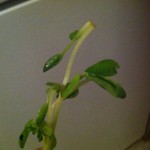Sprouting is an easy technique that, with a little practice, can give you fresh, nutrient-dense seedlings year-round. You can grow your own sprouts indoors, even in the heart of winter. In general, producing sprouts is as simple as placing some beans in a jar and helping them to maintain a humid environment for a few days. The process of sprouting is thought to give legumes a more complete nutritional profile because they are exiting their dormant seed phase and starting the process towards becoming a plant; thus, they have more diverse vitamins and proteins. Beans are purportedly easier to digest after being sprouted. I love soy bean sprouts, but there are many other legumes that are easy to grow and make great-tasting additions to salads, sandwiches, stir fries, or wherever your imagination takes you. I enjoy sprouts on salads with few other ingredients -- just lettuce, some cooked sprouts, and hot peppers -- but these tasty beans will make a great addition to your dish of choice.
[caption id="attachment_1622" align="alignleft" width="150"] bean sprouts[/caption]
[caption id="attachment_1623" align="alignleft" width="150"]
bean sprouts[/caption]
[caption id="attachment_1623" align="alignleft" width="150"] bean sprouts[/caption]
[caption id="attachment_1624" align="alignleft" width="150"]
bean sprouts[/caption]
[caption id="attachment_1624" align="alignleft" width="150"] bean sprouts[/caption]
bean sprouts[/caption]
Ingredients:
2 Tbsp of one of the following: mung beans, soy beans, alfalfa seeds, lentils, or adzuki beans (alternatively, try a sprouting mix)
Lots of fresh water, as described below
Directions:- Rinse beans and remove any debris.
- Soak beans in about 2 cups of water in a covered jar for 8-12 hours, or overnight.
- Drain the water, rinse the beans a few times, and refill the jar with fresh water until the beans are submerged.
- Place beans in a sprouting jar specially designed for growing seedlings. Alternatively, place beans in a sterilized glass canning jar and cover with a sprouting lid.
- Place jar in a dark place with good ventilation.
- Rinse the sprouts twice a day with fresh, clean water. This is as easy as flowing water into the jar, swirling the sprouts for a few seconds, and draining the water. Repeat for several days.
- Remove sprouts from the jar when they are the desired size.
Tips and Notes:
The Sproutmaster kit from Rainy Day Foods is a good sprouting system, and delivers consistent results.
I have tried stretching clean cheesecloth over the lid of a mason jar in lieu of a sprouting lid. I did not have good results, though others have had success with this method.
Although eating raw sprouts is generally considered safe, I recommend thoroughly cooking your sprouts before using them in recipes. I even cook my sprouts before putting them on my salad, I like the mix of warm and cool veggies in every bite.
Do not sprout large beans such as kidney, black, or pinto beans -- they may be toxic.
Your sprouts will be white in color, not green -- the sprouts in my pictures look different because I tried sprouting green peas, which must be planted before pea shoots can be harvested. They have more chlorophyll (the chemical that makes plants green) because they were growing in the sun.
Contributed by Kate WiltClick here to view sprouting seeds and seed sprout kits

